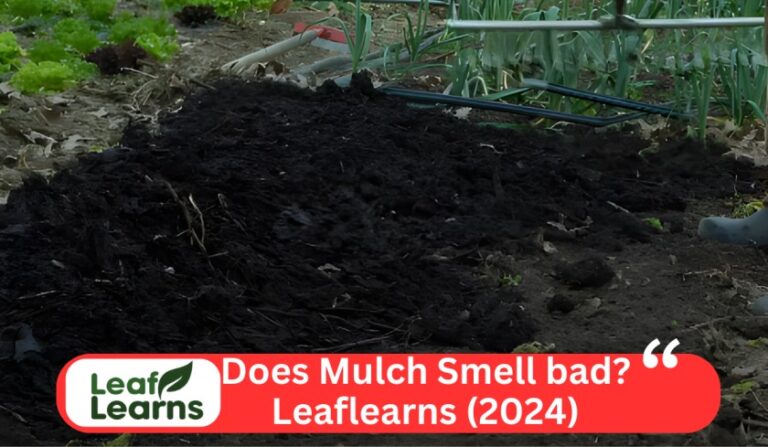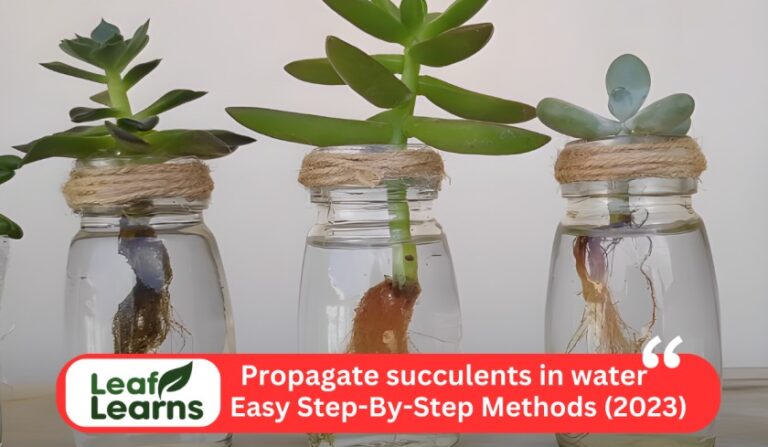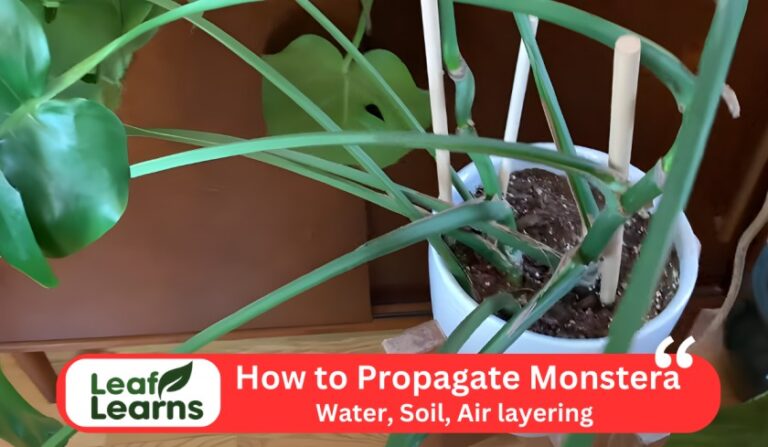Monstera Problems and Solutions How to fix it (2023)
Monstera problems can vary from insect infestations such as mealybugs to discolored foliage due to over-watering. Resolving these problems can involve modifying irrigation techniques, improving soil drainage, supplying suitable lighting, and monitoring pests closely.
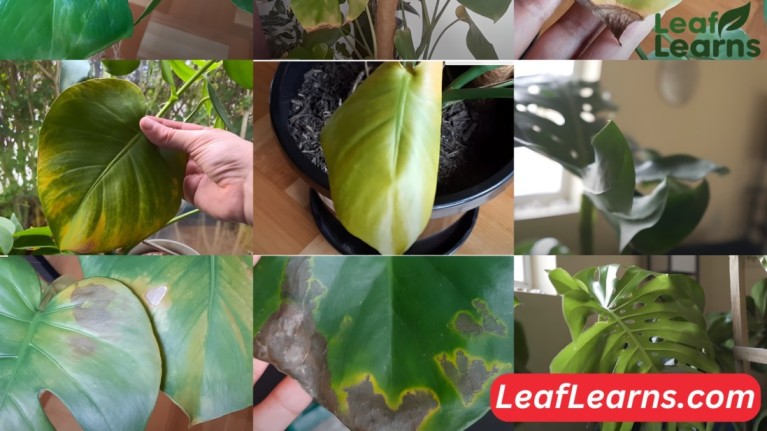
Fixing these issues will support the growth of your Monstera and preserve its unique lush look.
| Yellowing Leaves | Overwatering, inadequate light | Adjust watering and provide proper lighting. |
| Black or Darkened Leaves | Overwatering, poor drainage, diseases | Repot, improve drainage, isolate diseased plants. |
| Wilting or Drooping | Underwatering, root issues, low humidity | Water appropriately, inspect roots, increase humidity. |
| Brown Leaf Edges | Low humidity, underwatering | Use a humidity tray or mist leaves, water consistently. |
| Pests (e.g., mealybugs) | Infestations | Treat with neem oil or insecticidal soap, isolate affected plants. |
| Slow Growth | Inadequate light, root-bound, poor soil | Provide brighter indirect light, repot if root-bound, use well-draining soil. |
| Powdery Mildew | High humidity, poor air circulation | Improve ventilation, reduce humidity, use fungicides if necessary. |
| Dropping Leaves | Stress, overwatering, diseases | Diagnose the root cause, address accordingly. |
Contents
- 1 Yellowing Leaves
- 2 Brown Spots on Leaves
- 3 Curling or Wilting Leaves
- 4 Lack of Fenestrations
- 5 Overwatering leading to root rot
- 6 Dry and crispy leaves due to underwatering
- 7 Inadequate drainage leading to waterlogged soil
- 8 Sunburn from Excessive Direct Sunlight
- 9 Insufficient Light Causing Slow Growth and Leggy Appearance
- 10 Low Humidity and High Humidity Cause Issue
- 11 UnderFertilization and overfertilization Problems:
- 12 Pest Infestations:
- 13 Yellowing, blackening, and webbing surrounding stems
- 14 Fungal diseases like powdery mildew affecting the leaves
- 15 Bacterial infections causing dark or black spots on leaves
- 16 Tearing or Damage to Foliage During Pruning
- 17 Deformed or Misshapen Leaves
- 18 Slow plant development and limited new foliage
- 19 Leggy growth, with long, spindly stems and fewer leaves
- 20 Difficulty in Propagating New Monstera Plants
- 21 Lack of Growth or Development of Aerial Roots
- 22 Asymmetrical or Uneven Growth Patterns
- 23 Yellow Spots on Monstera Leaves
- 24 Brown, Dry Tips on Monstera Leaves
- 25 Black or Darkened Leaves in Monstera
- 26 Common Monstera Problems Guide
- 27 Beyond Common Issues: Complex Monstera Challenges
- 28 FAQs
Yellowing Leaves
Owners of Monstera plants are frequently concerned about yellowing leaves, which can be an indication of a number of problems, such as overwatering, insufficient light, or nutritional deficiencies. This is the huge issue in Monstera Problems.

Given that it compromises the plant’s appearance and health, this may be upsetting.
Solution: How to Fix it
- Modify how often you water: Make sure the soil dries in between applications.
- Proper lighting: Make sure there is strong, indirect light.
- Feed enough by using a water-soluble, balanced fertilizer.
- Verify the health of the roots: If there is root rot, transplant.
- Use a humidifier or pebble tray to maintain humidity.
Brown Spots on Leaves
There are three possible causes of brown patches on Monstera leaves: fungal infections, sunburn, and overwatering.
The plant’s vigour and attractiveness are diminished by these ugly patches.
Solution: How to Fix it
- Move the plant out of the direct sunshine to change the lighting.
- Let the soil dry in between watering to avoid over watering.
- Apply a fungicide as prescribed to address fungus problems.
- Trim impacted areas: Cut away any damaged leaves.
- Keep the right amount of humidity: Make sure the humidity is right.
Curling or Wilting Leaves
It might be rather upsetting to see your Monstera plant’s leaves curling or fading.
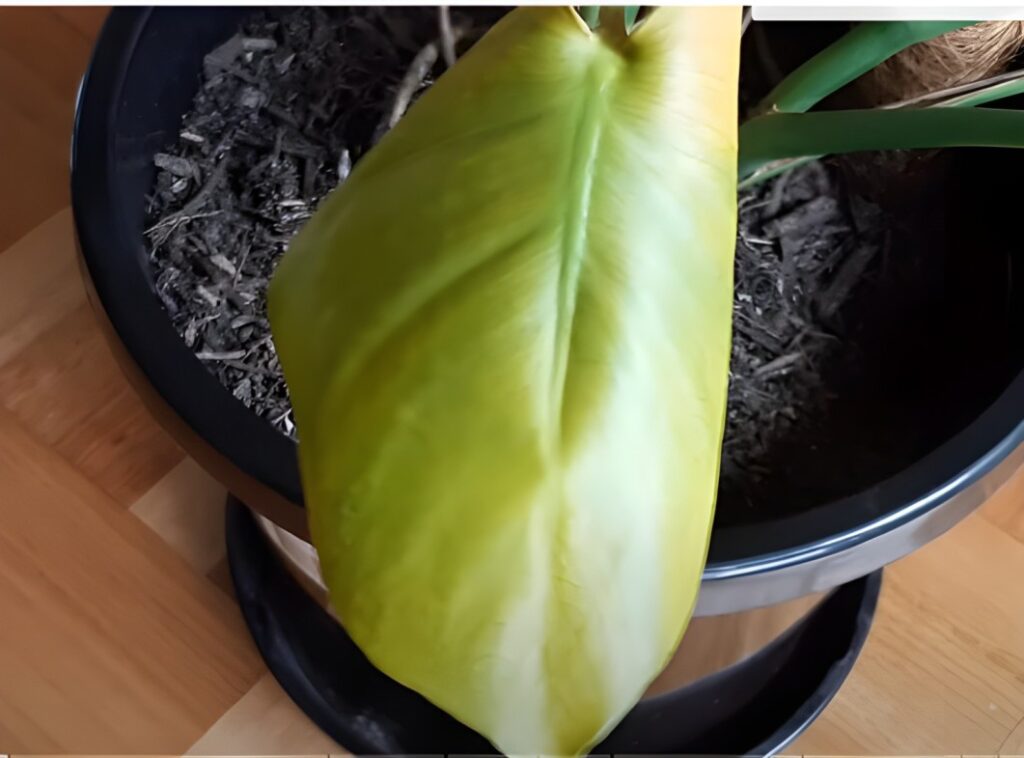
This problem is frequently an indication of stress, and healing your plant requires identifying the root of the problem. This is the also huge issue in Monstera Problems.
Solution: How to Fix it
- Modify Watering: Make sure the soil is properly hydrated; let it dry out in between applications.
- Evaluate Light: Make sure your Monstera is receiving the proper amount of light by shielding it from the sun.
- Optimise Humidity: Use a room humidifier or humidity tray to raise the humidity levels.
- Trim Damaged Leaves: In order to encourage new development, prune any badly damaged leaves.
Lack of Fenestrations
The absence of fenestrations, the lovely holes naturally seen in the leaves, on your Monstera can be the result of insufficient environmental conditions.
Monstera plants are characterised by fenestrations, thus it might be disheartening when they are absent.
Solution: How to Fix it
- Be patient; fenestrations may not appear on young Monstera plants; they do so as they mature.
- Provide the best lighting and humidity conditions possible to encourage fenestrations.
- Avert Overfertilization: This can prevent the formation of fenestration.
- Pruning: Remove unhealthy or crowded leaves.
Overwatering leading to root rot
It can be harmful to overwater Monstera plants since it might cause root rot.
The roots cannot breathe in continuously wet soil, which makes them susceptible to fungal diseases and sickly, drooping foliage.
Solution: How to Fix it
- Water Moderately: Don’t water until the top inch of soil has dried.
- Use Well-Draining Soil: Choose a potting mix that has good drainage.
- Select the Correct Pot: To avoid waterlogging, make sure the pot has drainage holes.
- Modify Your Watering Routine: Watering schedules should be customised to each plant’s requirements.
- Examine the Roots: Prune and address any decaying roots right away.
Dry and crispy leaves due to underwatering
Monstera plants that don’t get enough water may develop dry and crispy leaves. This is a frequent problem, particularly for people who frequently neglect to water their plants.
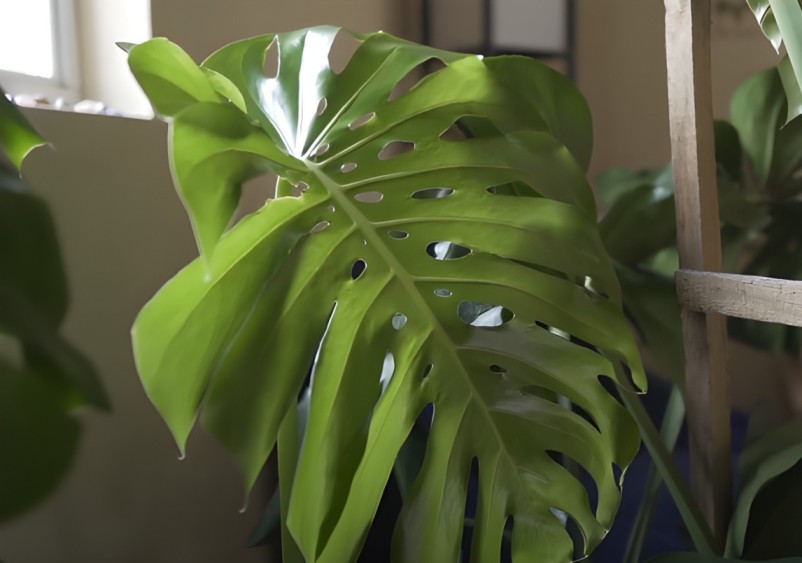
Solution: How to Fix it
- Regular Watering: Maintain a regular schedule for watering.
- Check Soil Moisture: To determine the amount of moisture in the soil, stick your finger into it.
- Use Soil That Drains Well: Plant your Monstera in soil that lets extra water escape.
- Select the Correct Pot: To avoid waterlogging, use a pot with drainage holes.
- Mist the Leaves: Mist the plant to increase humidity.
- Keep an eye on the humidity: To add more humidity, place a tray of water next to the plant.
Inadequate drainage leading to waterlogged soil
In monstera pots, improper drainage can lead to soggy soil, which can harm leaves and cause root rot.
By preventing oxygen from reaching the roots, this problem stunts plant development and results in yellowing or browning of the leaves.
Solution – How to Fix It
- Use well-draining soil: You may add perlite or orchid bark to ordinary potting soil, or you can use an aroid plant mix.
- Select appropriate pots: To allow extra water to drain, use containers with drainage holes.
- Empty saucers: Avoid letting extra water build up in saucers.
- Use water wisely: To avoid oversaturating the soil, modify the frequency and volume of your irrigation.
- Roots that have had root rot should be pruned in order to limit additional damage.
- Keep an eye on the humidity: Sufficient indoor humidity can aid in regulating the soil’s moisture content.
Sunburn from Excessive Direct Sunlight
Sunburn can occur in monstera plants if they get excessive amounts of direct sunlight. Brown spots appear on the leaves, which detracts from the plant’s overall appearance and health.
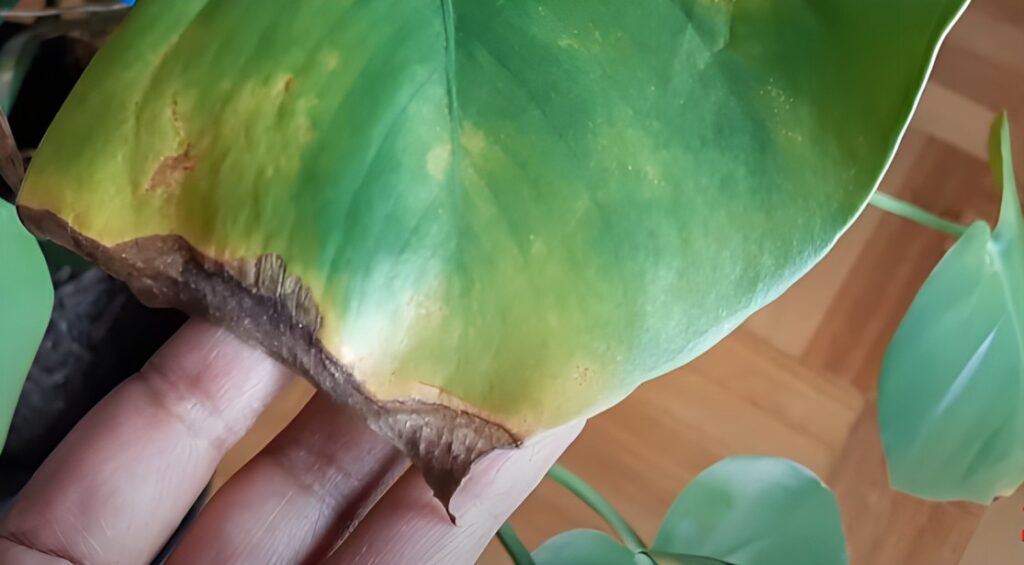
Solution: How to Fix it
- Modify Light Exposure: Transfer the plant to a spot that receives indirect or filtered sunlight.
- Use Blinds or Curtains: Use blinds or curtains to block off direct sunlight.
- Rotate the Plant: To guarantee uniform development and lower the danger of sunburn, turn the pot frequently.
Insufficient Light Causing Slow Growth and Leggy Appearance
If monstera plants are not given enough light, they may develop slowly and become lanky.
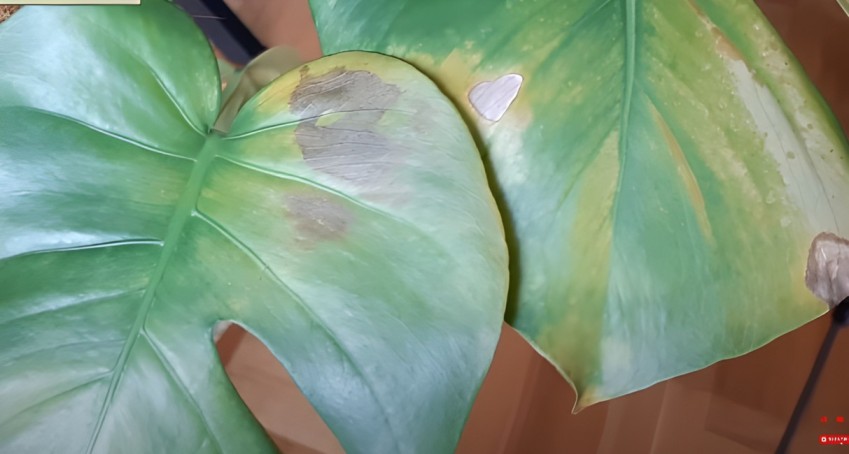
The plant’s innate beauty is diminished by the absence of light, which causes lengthy stems and widely separated leaves. This is the also huge issue in Monstera Problems.
Solution: How to Fix it
- Boost Light Exposure: Put the plant in a bright, indirect sunlight-filled space.
- Prune Leggy Stems: To promote bushier growth, trim leggy stems.
- Rotate the Plant: To guarantee that all sides receive enough light, rotate the pot on a regular basis.
Low Humidity and High Humidity Cause Issue
Monstera plants are vulnerable to a number of frequent problems that may compromise their general well-being.
Low humidity can cause dry leaf margins and browning, and excessive humidity can cause fungal infections like powdery mildew. These are two serious issues.
Solution for Low Humidity
- Raise the Humidity Levels: Place a humidity tray underneath the plant filled with stones and water.
- Plants may be grouped together to produce a more humid environment.
- Misting the plant frequently will help to keep the air sufficiently wet.
- Use of Humidifier: In dry areas in particular, use a room humidifier to keep humidity levels constant.
Solution for High Humidity
- Proper Ventilation: To avoid moisture accumulation, make sure there is adequate air movement surrounding the plant.
- Prevent Over watering: Give your Monstera just the right amount of water, waiting to water until the top inch of soil dries off.
- Fungicide Treatment: Apply an appropriate fungicide in accordance with the instructions if powdery mildew is found.
UnderFertilization and overfertilization Problems:
Nutrient-related difficulties might cause growth problems in monstera plants.
Underfertilization results in stunted development, whilst overfertilization can produce nutritional imbalances. The plant’s look and health are hampered in both situations.
Solution : Over-fertilization causing nutrient imbalances
- Modify Feeding Schedule: To prevent consuming too many nutrients, fertilize less often.
- Use Balanced Fertilizer: To avoid nutrient imbalances, choose a water-soluble, balanced fertilizer with a 20-20-20 NPK ratio.
- Flush the Soil: Water the plant deeply until the water runs out of the bottom of the container in order to remove extra salts and nutrients.
Solution : Lack of proper fertilization leading to stunted growth
- Frequent Feeding: To promote development, create a regular fertilization programme with a balanced liquid fertilizer.
- Keep an eye on the conditions of the soil, look for indicators of nutrient deficiencies (yellowing leaves, sluggish development), and modify fertilization as necessary.
- Observe label directions: To avoid overfeeding, make sure you always apply fertilizer according to the manufacturer’s instructions.
Pest Infestations:
Mealybugs, spider mites, and thrips are just a few of the typical pests that are prone to harming monstera plants.
Your Monstera’s health may be harmed by these pests, which may result in yellowing, wilting, or even falling leaves. Here’s how to deal with these annoying issues:
Solution: How to Fix it
- Regularly check your plant for symptoms of infection, such as small webs (spider mites), white clusters that resemble cotton (mealybugs) or tiny flying insects (thrips).
- Isolate the Infected Plant: To stop pests from infecting other plants, confine the afflicted Monstera.
- Eliminate Affected Leaves: To stop more harm, trim and dispose of deeply contaminated leaves.
- Treatment with Soap and Water: To get rid of pests, mix some mild soapy water and give the plant a gentle wash. After that, rinse with fresh water.
- Neem Oil Spray: To repel and suffocate bugs, spray leaves with a neem oil solution. Observe the dilution directions.
- Biological controls: Provide helpful insects, such as ladybirds, to consume the pests.
- Keep Humidity Up: Mealybugs and spider mites prefer dry environments, so raise humidity to ward them off.
- Regularly Clean and Prune: To encourage airflow, keep your Monstera tidy and clear of dirt. Also, trim any too dense foliage.
- Continue to keep an eye out for pests on your plant, and repeat treatments as required to keep the infestation under control.
Yellowing, blackening, and webbing surrounding stems
Monstera plants, distinguished by their eye-catching leaves, may have problems such as yellowing, blackening, and webbing surrounding stems.
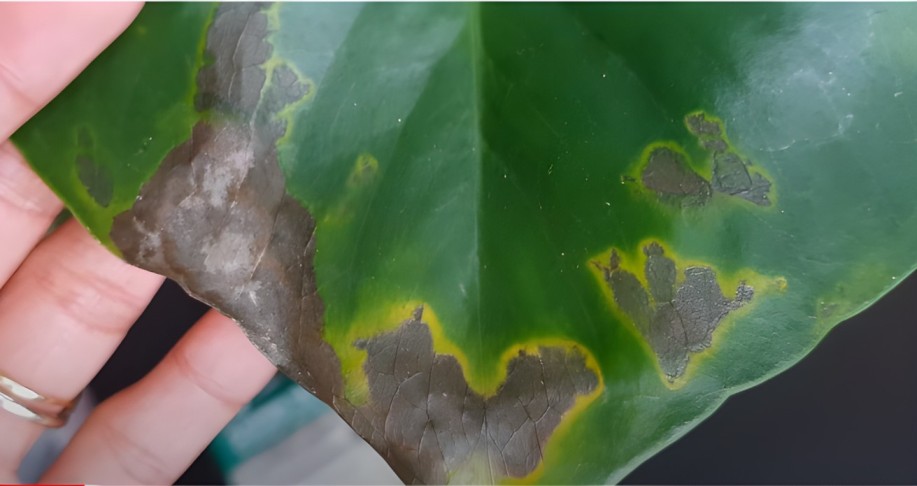
These signs point to a number of issues that might compromise the health and beauty of the plant.
Solution: How to Fix it
- Proper Watering: To avoid overwatering, make sure the soil is well-draining.
- When the top inch of soil seems dry, water it.
- Control Humidity: For healthy leaves, keep the humidity between 60 and 80%.
- Make use of a room humidifier or humidity tray.
- Lighting: The Monstera should be placed in a strong, indirect light source.
- Defend against intense, direct sunlight.
- Fertilization: During the growing season (spring and summer), apply a monthly application of a balanced, water-soluble fertilizer.
- Handle any black spots or webbing as possible signs of insect infestations.
- To get rid of pests, use neem oil or insecticidal soap.
- Pruning: To promote new development, trim any fading or damaged leaves.
- Encourage air movement inside the plant.
Fungal diseases like powdery mildew affecting the leaves
Powdery mildew is a frequent fungal disease that can affect monstera plants. The white, powdery material known as powdery mildew deteriorates the leaves’ appearance and health.
It is imperative that this issue be resolved quickly for the sake of your Monstera’s health.
Solution: How to Fix it
- Isolate Affected Plant: To stop the illness from spreading, keep the afflicted Monstera apart from other plants.
- Prune afflicted Leaves: To inhibit powdery mildew from spreading, trim and discard afflicted leaves.
- Boost Air Circulation: Make sure the plant has adequate ventilation to help lower humidity, which is a condition that the fungus loves.
- Modify Watering: Steer clear of over watering as wet circumstances promote the growth of fungi. Don’t water the foliage; water the soil.
- Apply Fungicidal Spray: As directed on the packaging, use a fungicidal spray designed especially for powdery mildew.
- Retain Ideal Humidity: Try to keep your Monstera’s humidity between 50 and 60 percent.
- Routine Maintenance: Use a moist cloth to wipe away dust from leaves since it may contain spores
Bacterial infections causing dark or black spots on leaves
Bacterial infections can cause monstera plants to acquire ugly dark or black patches on their leaves.
This can impede their development and general aesthetic appeal, thus it’s critical to take quick action to fix it.
Solution: How to Fix it
- Prune Affected Areas: To stop the spread of germs, trim diseased leaves.
- Sterilize Pruning Tools: To prevent cross-contamination, use alcohol to clean your shears or scissors.
- Enhance Air Circulation: Make sure you have enough ventilation to cut down on humidity, which can promote the growth of germs.
- Modify Watering Practices: Steer clear of overwatering, since this might exacerbate bacterial problems.
- Isolate Infected Plants: To stop the virus from spreading to healthy Monstera, quarantine the afflicted ones.
- Use Copper Fungicides: To fight bacterial infections, use a fungicide with a copper basis.
Tearing or Damage to Foliage During Pruning
During trimming, monstera plants frequently have problems like ripping or damage to their leaves, which can impair both their general health and aesthetic appeal.
To guarantee that the plant survives, this issue requires practical solutions.
Solution: How to Fix it
- Employ pristine, well-honed shears or scissors.
- Make a cut just above a leaf node to promote regrowth.
- Make neat, purposeful slices rather than ripping the leaves.
- To encourage strong development, remove any damaged or yellowing leaves.
- Check your Monstera often for problems and take quick action to fix them.
Deformed or Misshapen Leaves
There are a number of causes for deformed or malformed leaves, including inadequate maintenance and environmental factors.
These problems have an impact on your Monstera’s development potential and beauty, but they are fixable with the appropriate technique.
Solution: How to Fix it
- Make sure there is enough light without being in the direct sun.
- Retain the right amount of humidity; Monstera like between 60 and 80 percent.
- Periodically rotate the plant to encourage uniform development.
- Keep an eye on watering and let the soil dry out a little bit in between applications.
- If roots are confined, think about repotting to provide healthy development more room.
Slow plant development and limited new foliage
Monstera plants frequently struggle with sluggish growth and little new leaf formation, which makes them seem less colourful and lush.
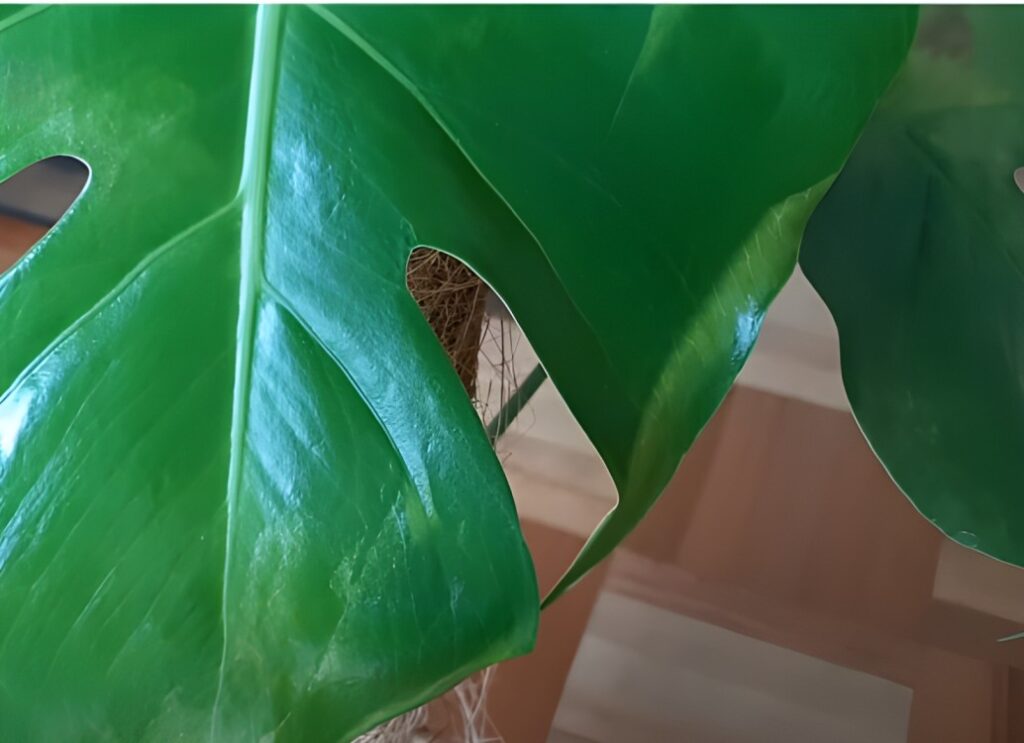
Numerous things, such as inadequate light, inappropriate watering, and poor nutrition, might be blamed for this.
Solution: How to Fix it
- Ideal Lighting: Because your Monstera loves strong, indirect sunshine, place it there.
- Proper Watering: Ensure that the soil drains adequately and that the top inch may dry out in between watering.
- Boost Your Nutrient Content: During the growth season, use a balanced liquid fertilizer to supply vital nutrients.
- Trim lanky or unhealthy growth to encourage the emergence of fresh foliage.
Leggy growth, with long, spindly stems and fewer leaves
Monstera plants frequently have lanky growth, which is typified by long, spindly stems and few leaves.
Numerous things, including insufficient light, poor maintenance, or the plant’s natural growth behavior, might cause this problem.
Solution: How to Fix it
- Modify Light Exposure: Make sure your Monstera gets enough of indirect, bright sunlight. Steer clear of the sun, since it might burn the leaves.
- To encourage balanced development, turn the plant frequently.
- Pruning and trimming: Make a cut slightly above a leaf node to trim the lanky stems.
- The plant becomes bushier as a result of this encouraging new growth from the nodes.
- Support the Plant: To help the plant grow, provide trellises or stakes.
- This keeps the stems straight and keeps them from bending.
- Watering a plant properly means giving it plenty of water, but letting the top inch of soil dry up before adding more.
- Root rot and poor growth might result from overwatering.
- Nutrient Boost: During the growth season (spring and summer), apply a balanced, water-soluble fertilizer.
- Every two to four weeks, fertilize to promote healthy growth.
Difficulty in Propagating New Monstera Plants
Monstera plants are prized for their eye-catching leaves and visual attractiveness, but many fans find it difficult to propagate new plants.
Many times, the issue is the result of other things including root rot, failed pruning attempts, and extended growth times.
Solution: How to Fix it
Ideal Circulation Conditions: For successful proliferation, make sure there is indirect sunlight and a humid atmosphere. To avoid root rot, use potting mix that drains properly.
Nutritious Slices: For propagation, use healthy stems with a minimum of one node. To lower the chance of illness and contamination, make clean incisions.
Sufficient Moisture and Support Sufficiently moisten the soil without flooding it. Stakes or supports can be used to promote healthy development and stability.
Observation and Patience: Recognize that spreading Monstera might take some time, and exercise patience. Keep an eye out for any indications of development on a regular basis and modify treatment as necessary.
Lack of Growth or Development of Aerial Roots
Monstera plants, renowned for their breathtaking foliage and recognizable aerial roots, may experience difficulties with the growth of their roots.
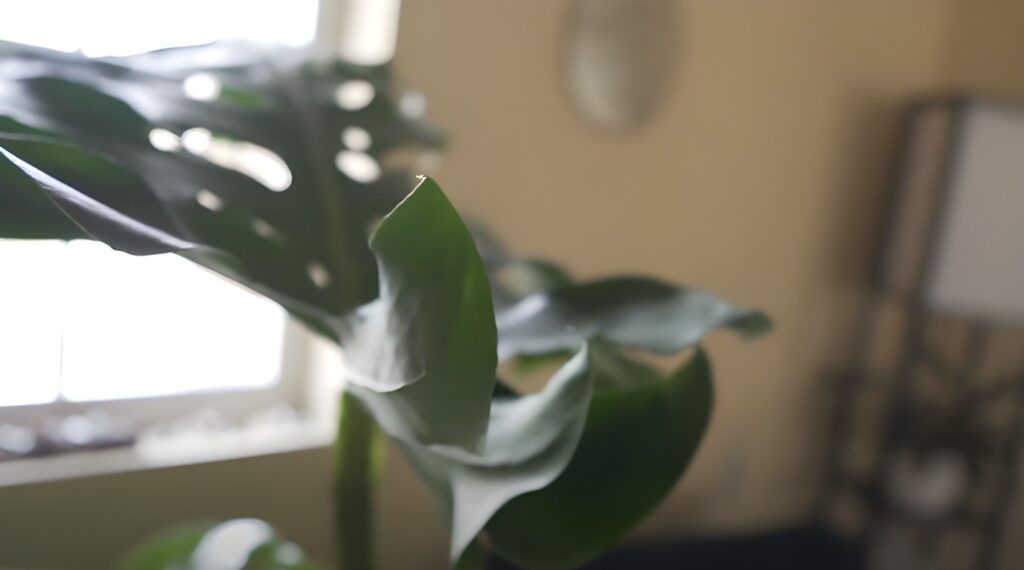
These roots are essential for support and nutritional absorption. The general health and beauty of the plant are harmed when they don’t grow as predicted.
Solution: How to Fix It
- Maintain humidity levels between 50 and 60 percent for optimal results.
- Regularly mist your plant to increase humidity, paying particular attention to the aerial roots.
- Employ a Humidifier: For steady moisture, use a humidifier close by.
- Remove any diseased or damaged aerial roots by doing a root pruning.
- Offer Support: To ensure stability, use moss poles or stakes.
Asymmetrical or Uneven Growth Patterns
Popular for their stunning leaves, monstera plants can exhibit asymmetrical or uneven growth patterns, which can lessen their aesthetic value.
A number of things, including as sun exposure, hydration, and trimming methods, might cause this problem.
Solution: How to Fix it
- Rotate Your Plant: To maintain balanced development, rotate your monstera on a regular basis to provide all sides equal exposure to sunshine.
- Modify Lighting: To promote balanced growth, place the plant in bright, indirect light.
- Pruning: To encourage branching and preserve a more symmetrical appearance, cut longer vines.
- Watering Consistency: To avoid overgrowth on one side, keep a regular watering schedule and let the soil partially dry in between watering.
- Fertilize Moderately: To promote healthy growth without encouraging excessive elongation, use a balanced, water-soluble fertilizer.
Yellow Spots on Monstera Leaves
On Monstera leaves, yellow patches may indicate a number of underlying problems, such as pests or environmental stress.
To restore health to your plant, it is essential to precisely assess the exact issue.
Solution: How to Fix it
- Examine the leaves for indications of common pests such as mealybugs, aphids, or spider mites.
- To treat the infestation, apply insecticidal soap or neem oil.
- Modify Lighting: Make sure your Monstera gets bright, indirect light—not direct sunshine.
- Take it out of direct sunlight and from shady areas.
- Watering Techniques: Yellow patches may result from either over watering or under watering. When the top inch of soil seems dry, water it.
- Make sure there is enough drainage to avoid root rot.
- High humidity is preferred for monstrosa. To raise the moisture content, spray the leaves or use a humidity tray.
- Deficiency in Nutrients: Yellow patches may be an indication of insufficient vital nutrients. Apply a diluted, well-balanced liquid fertilizer.
- Pruning: To promote new growth and stop the development of problems, trim any damaged leaves.
Brown, Dry Tips on Monstera Leaves
Indoor gardeners love Monstera plants, but a typical problem is dark, dried leaf tips.
There are a number of reasons why these unattractive lesions may appear, including poor environmental conditions and maintenance.
Solution: How to Fix it
- Control Humidity: Try to keep your humidity between 50 and 60 percent.
- Watering schedule: Modify it so that you water when the top inch of soil is dry.
- Appropriate Drainage: To avoid root rot, make sure your container has adequate drainage.
- Pruning: To encourage better development, cut off any impacted brown tips.
- Use a balanced, diluted fertilizer sparingly during the growth season.
- Sunlight Adjustment: Keep your Monstera out of bright, direct sunshine.
- Keep an eye on Pot Size: When the plant is root-bound, repot it.
- Clean Leaves: To aid in photosynthesis, dust clean the leaves.
Black or Darkened Leaves in Monstera
It might be upsetting to have black or darker foliage on your Monstera plant.
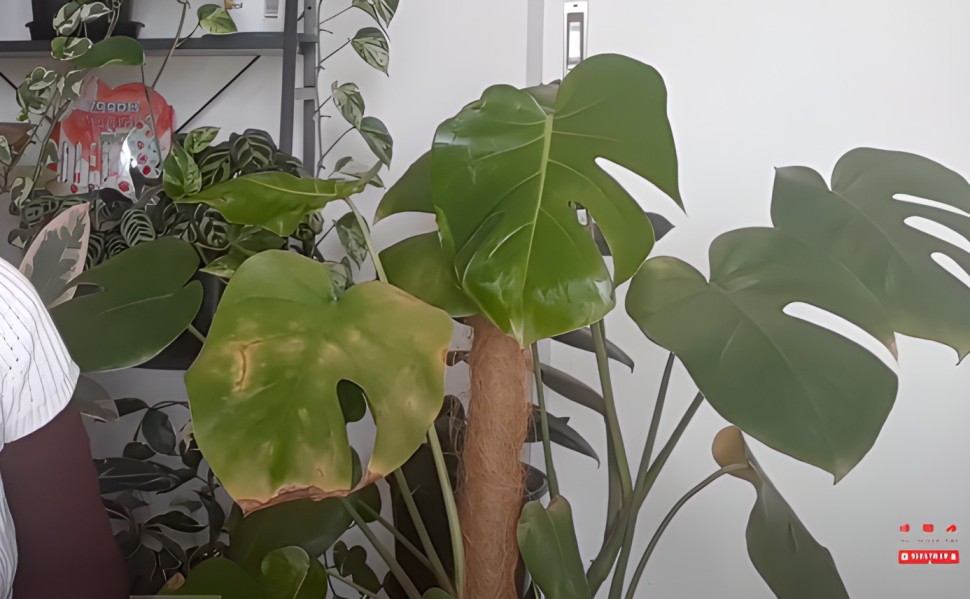
Usually, over watering, improper drainage, or illnesses such root rot are the causes of this problem. To get your Monstera’s health back, do the following:
Solution: How to Fix it
- If the top inch of soil is dry, water only after checking the soil moisture with a finger.
- Make sure there are drainage holes in your pot to avoid water buildup.
- Repotting Think about repotting into well-draining soil if root rot was brought on by excessive watering.
- When repotting, trim away any diseased black leaves and broken roots.
- Better Drainage: To enhance soil drainage, use a potting mix made specifically for aroid plants, such as Monstera.
- To improve aeration, add a layer of perlite or orchid bark.
- Command Humidity To prevent fungal problems, use a humidity tray or spray to maintain moderate humidity levels.
- Examine for Insects: Look for and cure any common pests, like as mealybugs or aphids, right away.
- Separate Sick Plants: To stop the spread, isolate any seriously impacted Monstera plants.
Common Monstera Problems Guide
In the world of houseplants, common monstera problems are a topic of concern for many enthusiasts. Monstera adansonii leaf problems, along with other varieties like monstera deliciosa, often lead to the need for monstera adansonii troubleshooting.
Common issues include monstera plant care problems such as over watering or under watering, which can result in monstera problems with pictures, leaving plant owners worried about the health of their beloved monstera. The good news is that there are monstera plant solutions available to address these common monstera problems.
By understanding the needs of your specific monstera variety, whether it’s monstera albo, mini monstera, swiss cheese monstera, or monstera thai constellation, you can prevent and overcome monstera problems with ease. And for those who find solace in books and movies, it’s fascinating to explore the parallels between monster problems by Lindsay Price or the tales of monstrous creatures in breakout edu answers.
Just like in these stories, your monstera can have its own journey of growth and challenges, ultimately leading to a thriving and beautiful plant. So, while it’s crucial to be prepared for monstera bug problems or monstera problems killing cats, remember that with the right care and attention, your monstera can overcome these hurdles, just like the characters in your favorite monster-themed tales.
Beyond Common Issues: Complex Monstera Challenges
But what if your monstera issues go beyond the common problems? Sometimes, the plant health issues are far more complex. For instance, problems with monstera adansonii might require unique solutions compared to monstera deliciosa.
And when you have monsters like monster circle problems, monster drink problems, and monster energy problems lurking around your monstera, it’s crucial to take swift action. By understanding the dynamics of monstera growth and ensuring the right monstera propagation techniques, you can pave the way for a healthier plant.
It’s like learning to solve monster math problems; the more you practice, the better you become. In the end, it’s all about finding the balance between caring for petite monstera plants and the more robust monstera xl or monstera xxl varieties.
Remember, each monstera has its unique personality, just like the characters in monster problems movies and books. Whether your monstera is a seasoned 3-monster-per-day survivor or a monstera in its problematic teenage years, with proper care, it can flourish into a beautiful, vibrant, and healthy addition to your indoor garden.
FAQs
What does an unhealthy Monstera look like?
An unhealthy Monstera may display black or yellowing leaves, wilting, and stunted growth.
What are common diseases for Monsteras?
Common diseases affecting Monsteras include root rot, powdery mildew, and mealybugs.
What’s wrong with my Monstera plant?
If your Monstera exhibits dark or discolored leaves, it could be due to over watering or insufficient light.
How do you make Monstera grow well?
Use well-draining soil, water when the top inch of soil is dry, and give indirect sunshine for your Monstera to grow well.
How do you fix a troubled Monstera?
Take care of your Monstera by monitoring for pests, adjusting watering, and improving drainage. You should also clip any damaged leaves.

